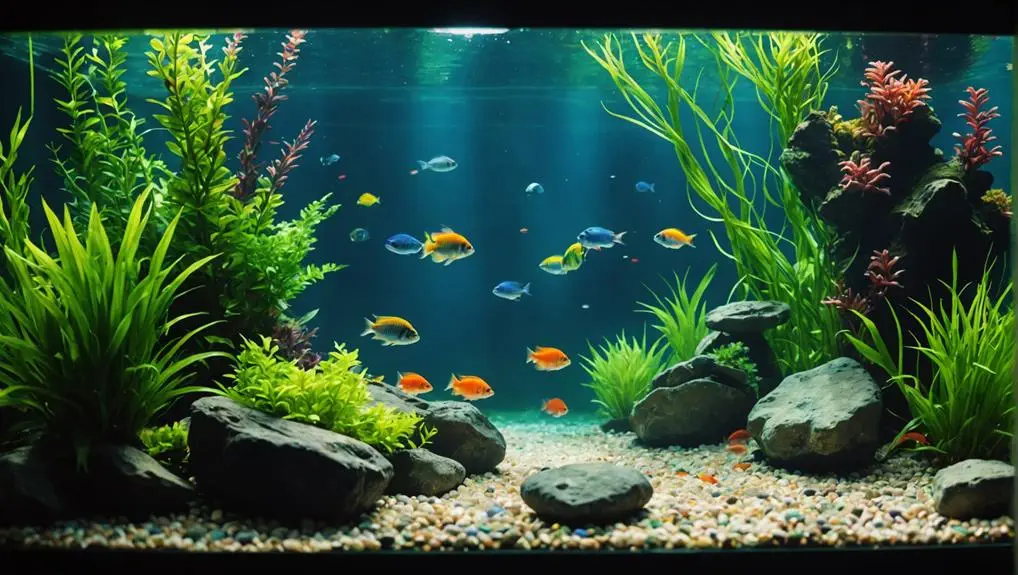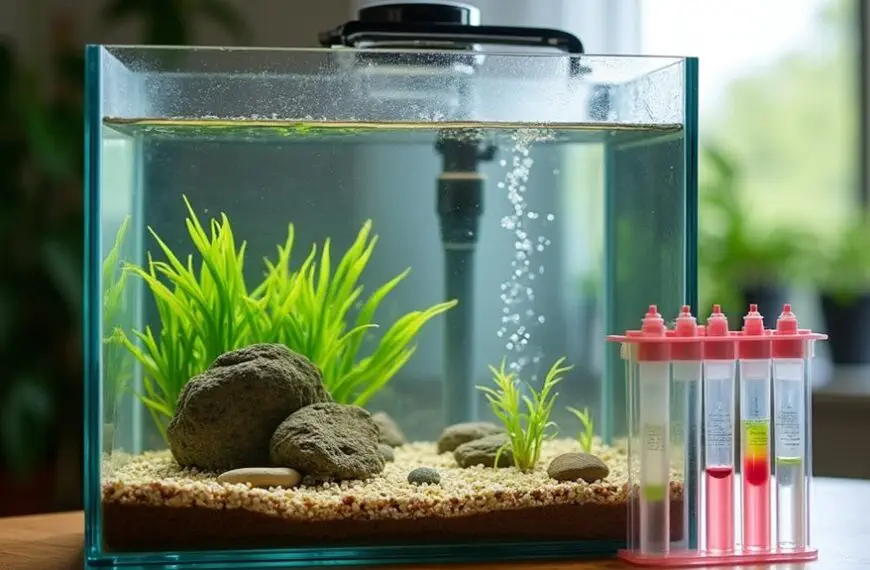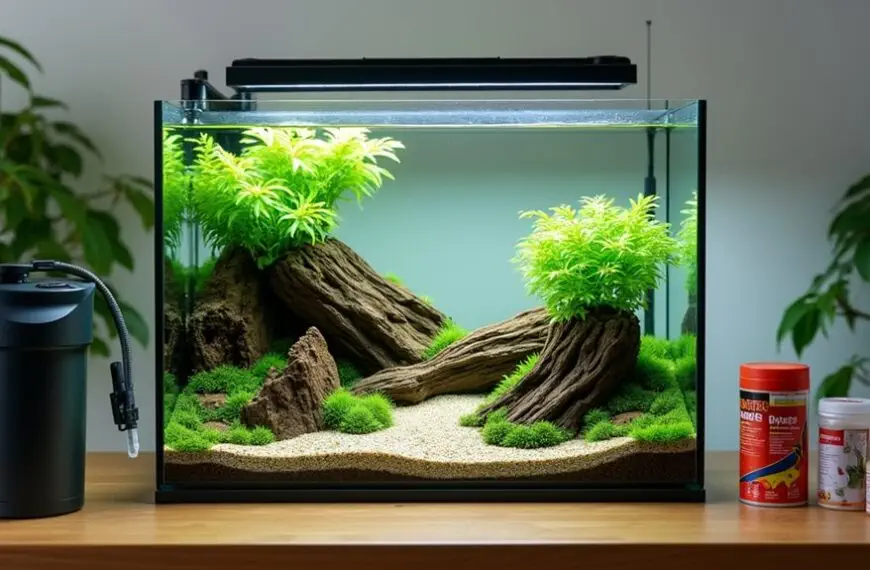To create a vibrant fish tank that your aquatic buddies will love, you'll need seven must-have items. Start with a sturdy aquarium and stand, and don't forget a reliable filtration system to keep the water clean. An adjustable heater and thermometer will ensure your fish stay comfy. Lighting options, like energy-efficient LEDs, are crucial for a stunning display. Choose the right substrate for a safe, natural environment. Maintain water quality with regular testing, and grab handy maintenance tools like a gravel vacuum and algae scraper. Stick around, and you'll uncover even more tips to keep your tank thriving!
Contents
Aquarium and Stand
When you set up your fish tank, choosing the right aquarium and stand is crucial for ensuring a healthy environment for your aquatic friends. If you're considering larger tanks, like those 20 gallons or more, you're on the right track! They provide better swimming space for your fish and help keep water parameters stable.
Now, let's talk about the stand. You need one that's sturdy enough to hold the weight of a fully filled tank, which can be about 10 lbs. per gallon. That's a lot of weight!
If you're going for glass tanks, they're popular but need proper support. Acrylic tanks, while lighter and shatterproof, also require solid bottom support to maintain their integrity.
Don't forget about warranties—they might be void if your aquarium isn't on appropriate stands. If you're handy, check out some DIY stand plans to create a custom setup that provides proper support for your fish tanks.
Your fish will thank you for the thoughtful planning! A well-chosen aquarium and stand combo can make your aquatic adventure even more enjoyable.
Filtration System
When it comes to your fish tank, a good filtration system is a game changer.
You've got options like canister filters for larger setups or bio-wheel systems that are champs at keeping things clean.
Types of Filters
Understanding the types of filters available for your fish tank is essential for maintaining a healthy aquatic environment. Each type plays a vital role in keeping your water clean and your fish happy. You'll find that choosing the right filter can make all the difference.
Here are the main types of filters to consider:
- Mechanical Filtration: This captures debris using filter pads or sponges, helping to keep your water clear.
- Chemical Filtration: This uses media like activated carbon to remove toxins and impurities, ensuring a safer habitat.
- Biological Filtration: This is crucial for growing beneficial bacteria that break down harmful ammonia and nitrites from fish waste.
- Canister and Hang-On-Back Filters: Canister filters are perfect for larger tanks, while hang-on-back filters are great for smaller setups or beginners.
With the right filter, you'll ensure optimal aquatic life by promoting effective water circulation and a suitable filter flow rate.
Flow Rate Importance
A filter's flow rate directly impacts the health of your fish tank, making it a key factor in your filtration system. Ideally, your filter flow rate should be four times your tank volume each hour. So, if you have a 20-gallon tank, your filter should pump at least 80 gallons per hour. This flow rate is crucial for maintaining water quality and preventing stagnant areas where waste can pile up and harmful bacteria can thrive.
With the right flow rate, your aquarium filter can effectively perform mechanical, biological, and chemical filtration. It helps keep the water clear and healthy, ensuring your fish are happy and thriving.
Don't forget that regular water changes also play a part in maintaining good water chemistry, but without proper flow, you might be swimming upstream!
Choosing the right filtration system, like a canister filter for larger tanks, can provide the necessary flow rates.
Heater and Thermometer
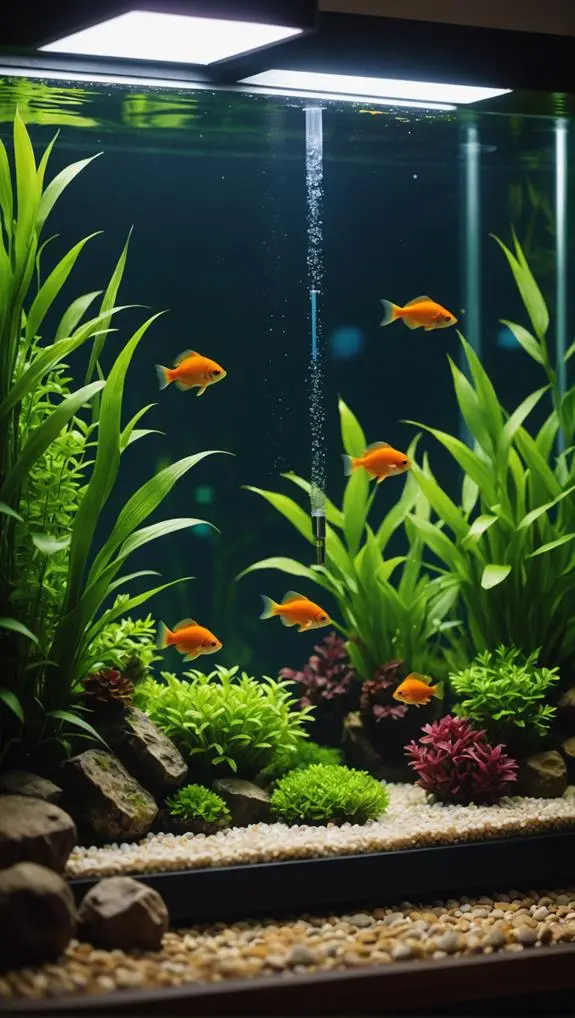
Maintaining a stable environment is crucial for the health and happiness of your tropical fish, and that's where a reliable heater and thermometer come into play. You want to ensure your aquatic friends are comfy, and these two pieces of equipment are essential for that.
Choosing the right heater is important. Most tropical fish thrive at temperatures between 75°F and 80°F, so an adjustable heater allows for precise temperature control. Make sure it's rated for your tank size—typically around 5 watts per gallon works well.
Don't forget the thermometer! Whether you go for digital or liquid, it's vital for accurately monitoring water temperature. Regular checks can prevent fluctuations that stress your fish or threaten their survival.
Here are some key points to remember:
- Use an adjustable heater for better control.
- Match the heater's wattage to your tank size.
- Regularly check the thermometer for accuracy.
- Monitor both pieces of equipment to avoid mishaps.
Lighting Options
How can you create the perfect lighting environment for your fish tank? First off, consider using LED lights. They're not only energy-efficient but also produce less heat and last much longer than traditional bulbs. Plus, your fish won't mind the lower electricity bill!
If you're on a budget, fluorescent lighting is a solid choice. T5 and T8 bulbs provide a good light spectrum that promotes both fish health and plant growth.
Now, if you have a larger or heavily planted tank, metal halide lights might be what you need. They offer intense illumination, but keep in mind they consume more energy and can heat things up a bit—so monitor that temperature!
Whatever you choose, remember to think about the specific light requirements of your plants and fish. Different species thrive under different light spectrums, especially red and blue wavelengths.
Automating light cycles with timers can help mimic natural day and night rhythms, which is crucial for keeping your aquatic friends happy. With the right lighting systems, you'll create a vibrant underwater world that both you and your fish will love!
Substrate Selection
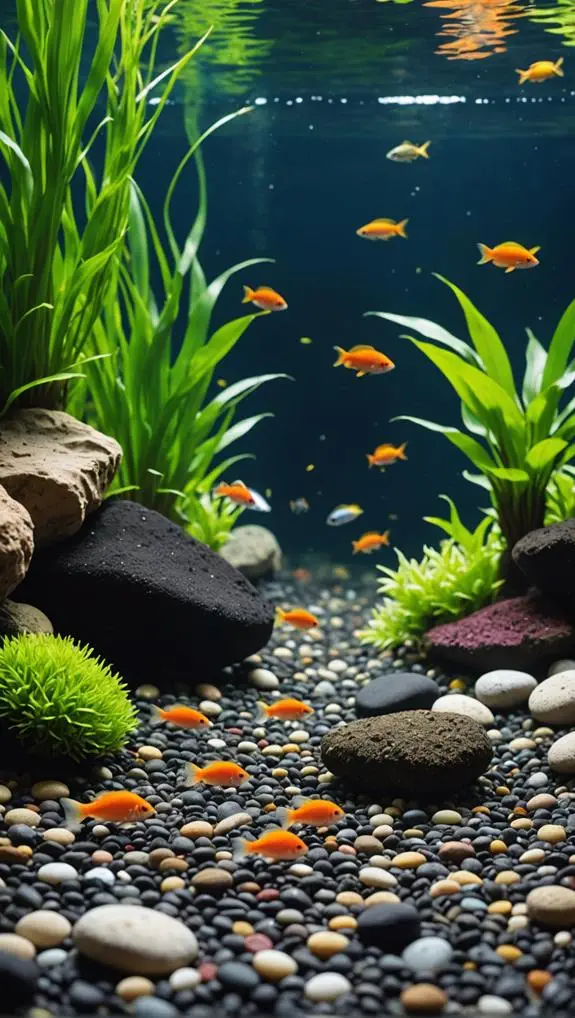
Creating a vibrant aquatic environment doesn't just stop at lighting; substrate selection plays a key role in your fish tank's overall health.
Choosing the right substrate isn't just about looks; it affects water clarity, fish safety, and even plant growth.
Here's a quick rundown of popular options:
- Gravel: A stable base for most freshwater tanks, with sizes ranging from 1/8 to 1/4 inch. It's great for fish to dig and explore.
- Sand: Perfect for bottom-dwelling fish that love to sift through it. Its fine texture creates a natural look and feel.
- Plant substrates: Enriched with essential nutrients, these are designed to keep your plants thriving, ensuring they contribute positively to your aquarium.
- Rinsing: Always rinse new substrates thoroughly to remove dust and contaminants. This ensures both water clarity and fish safety.
Water Quality Management
Regularly managing water quality is crucial for the health of your fish tank. You want your aquatic friends to thrive, and that starts with clean, balanced water. Quality filtration is essential, so aim for a system that can handle at least four times the tank volume per hour. Trust me, your fish will thank you!
Monitoring parameters like ammonia, nitrite, and pH levels is key. Monthly testing after the initial cycle ensures a stable environment. Don't forget to use a good water conditioner, like API Stress Coat, to remove harmful elements from tap water. Your fish deserve the best!
Implement weekly water changes of about 25% to keep waste at bay. A gravel vacuum will be your best buddy here, helping to clean while you chat with your fish.
Lastly, consider water softening methods like using rainwater or chemical filters to keep hardness levels just right. Your fish will be happier and healthier when their water conditions are perfect.
Maintenance Tools

When it comes to keeping your fish tank in tip-top shape, having the right maintenance tools makes all the difference.
You'll want to stock up on essential cleaning equipment, reliable water quality testing kits, and efficient water change tools to keep your aquatic friends happy and healthy.
Trust me, with a little effort and the right gear, your tank won't only look great but also provide a safe haven for your fish!
Essential Cleaning Equipment
Keeping your fish tank clean and healthy relies heavily on having the right maintenance tools at your disposal. With the right cleaning equipment, you'll ensure a happy environment for your aquatic friends.
Here are some essentials you shouldn't overlook:
- Gravel vacuum: This tool is a lifesaver for substrate cleaning during water changes, helping you remove debris and waste stuck in the gravel bed.
- Algae scrapers: Use these to keep your aquarium glass sparkling! They come with plastic blades or algae pads that tackle stubborn algae without scratching.
- Siphon tool: Simplifying water changes, this tool allows you to drain and fill your tank easily, with minimal disruption to your fish's world.
- Water buckets: Make sure to label these "For Aquarium Use Only" to prevent chemical contamination when transferring water.
Also, don't forget about fish handling nets! Having assorted sizes handy makes maintenance tasks smoother, ensuring you can handle your fish gently and reduce their stress.
With these tools, you're well on your way to creating a thriving habitat. Your fish will appreciate your efforts, and you'll find joy in maintaining their home!
Water Quality Testing
To ensure your fish thrive, monitoring water quality is crucial. Regular water quality testing helps you keep an eye on ammonia, nitrite, nitrate, and pH levels. These elements can make or break your fish's health. You'll want to grab an Aquarium Water Test kit, like the API Freshwater Master Test Kit or Tetra EasyStrips. Testing monthly after your tank is cycled is a great habit to form.
Before you add tap water to your aquarium, always use a water conditioner. This step removes harmful substances like chlorine and heavy metals, making the water safe for your aquatic friends.
Keep track of your test results; documenting them can help you spot patterns or recurring issues that need attention. Trust me, your fish will thank you for it!
Also, perform water tests before making changes or if you notice any signs of distress in your fish. Sudden changes can stress them out, and we definitely don't want that!
Efficient Water Changes
Streamlining your water changes can make a significant difference in maintaining a healthy aquarium.
It's not just about keeping your tank clean; it's a way to show your fish you care!
Efficient water changes can be made easier with the right tools. Here are some must-haves:
- Gravel vacuum: Perfect for sucking up that pesky debris lurking at the bottom.
- 5-gallon buckets: These make transporting water a breeze, reducing spills and ensuring safe handling.
- Infrared thermometer: Quickly checks water temperature, so your fish don't get shocked when you do a partial water change.
- Measuring cups: Cut down on the guesswork for your water conditioner. Your fish will thank you!
With these tools, you can make your water changes smooth and effective.
Using a gravel vacuum helps maintain water quality while those 5-gallon buckets keep the process tidy.
The infrared thermometer ensures the temperature stays just right, and measuring cups let you dose water conditioner accurately.
By investing in these efficient tools, you're not just changing water—you're creating a nurturing environment for your aquatic friends.
Happy fishkeeping!
Frequently Asked Questions
What All Do I Need for a Fish Tank?
To set up your fish tank, consider tank size, substrate options, and filtration systems. Monitor water parameters, choose lighting types, explore decoration ideas, implement tank cycling, and establish feeding strategies for optimal health maintenance.
What Equipment Is Needed in a Fish Tank?
To set up your tank, you'll need filtration systems, heating solutions, and water conditioning supplies. Choose substrate types and aquarium lighting options wisely, ensuring fish species compatibility while following tank maintenance tips and algae control methods.
What Should I Put My Fish Tank On?
When it comes to placing your fish tank, you'll want sturdy fish tank stands that ensure stability, balance weight distribution, and provide height accessibility. Choose moisture resistant materials for aesthetic enhancements and ease of fish tank maintenance.
What Are 5 Things That Help to Keep a Fish Tank Clean?
To keep your fish tank clean, focus on water quality through regular testing and water changes. Maintain your filter, control algae, select appropriate substrate, and ensure decor upkeep for optimal fish health and environment.
Final Thoughts
So, now that you know the must-have items for your fish tank, it's time to dive in! Setting up your aquarium can feel overwhelming, but don't worry—you're not alone. Think of your tank as a little underwater world where your fish can thrive. Just like any good relationship, it needs care and attention. With the right equipment, you can create a vibrant home for your finned friends. Remember, happy fish make for a happy you!

